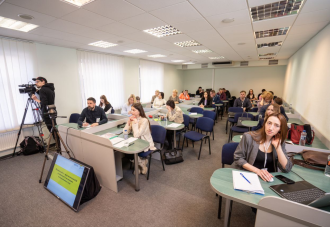Can a strategy session help an NGO? Why do we prepare strategy documents and then they don’t work? And what should we do to make strategizing really effective?
A discussion on the topic of strategy sessions for CSOs took place in December at the XI Civil Society Development Forum.
“Strategy session is perhaps the most popular term in the civic sector. Whenever you ask NGOs what they need or what difficulties they face, what can help them overcome such difficulties, probably about 70% answer that a strategy session is needed,” noted the moderator of the meeting, Olena Matviichuk, organizational and existential coach.
The discussion was attended by Maria Nasiedkina, civic sector management consultant and coach, Solomiia Maksymovych, head of educational programs at the UCU Institute of Leadership and Management, Dmytro Yakymets, organizational development expert, Oksana Hliebushkina, executive director of NGO “New Generation” Civic Center, provider of organizational development services.
Strategy session: what it means and its peculiarities
“It is important to understand that a strategy session is a facilitated group work of the whole team or part thereof on strategically important issues and decisions that affect the movement of the team, organization in a certain period of time in the future,” says Mariia Nasiedkina.
In her opinion, organizations may confuse strategy sessions with tactics ones, when the team needs to develop an operational plan for the next period of activity. Instead, ideally, a strategy session should include an analysis of the past, present, and trends to draw conclusions and decide what we are choosing for ourselves and our future.
Oksana Hliebushkina adds that a facilitator plays a special role in a strategy session, helping to find answers, even if the questions are scary or uncomfortable: “This, I think, is the most valuable thing that happens during the session – this sincerity and frankness in answering the questions they ask themselves.”
She is convinced that when talking about the bridge between the past and the future, it is important not to lose the answers to the question: “Who are we now?”. After all, the world is dynamic, processes are changing, and the point of reference, the state in which the organization is, must be recorded.
Solomiia Maksymovych believes that another important task of the strategy session is to synchronize the team, to understand common values, common vision: “This is the first moment in the strategy session, when we remind ourselves of all this, talk about it and understand what motivates us to act.”
According to Dmytro Yakymets, the most typical form of a strategy session in the civic sector is usually a group facilitation, with 3-4 to 15-20 participants.
“I often repeat Yevhen Hlibovytskyi’s words that strategy is not only about what we do, but what we won’t do. And it is also a good story about freeing up resources and space for what we will do,” adds the expert.
Why the demand for strategy sessions is high, but the strategic plans implementation is quite low?
According to Oksana Hliebushkina, this is due to the process of growing up for the organization: “How they treat strategizing processes depends on the stage the organizations are at. If they treat it as an external requirement (from donors, surroundings, or projects must comply with strategies, or this question is asked in the applications and it must be answered somehow) – then it is not an internal need”.
According to her, the document will become alive when it is part of the organization’s system, its organism. “It all depends on the level of internal culture and the level of organization maturity. We have to understand that it may not happen naturally. Therefore, we must form for organizations an attitude to this process as a system, not a single event called “Strategy Session” once every 3 years”.
Solomiia Maksymovych says that she already has a completely different experience with strategic plans, because the situation in Ukraine affected organizations, their understanding of themselves and where they should move and what they should do.
“We are moving in the theory of uncertainty, we do not know the end point “B”, so those goals that we could set for ourselves according to SMART, we do not quite manage to reach. But if we understand the direction in which we are moving, it is already easier for us, if we pass part of the way under these conditions, this is already our movement, we are moving in small steps, and this is already success,” explains the expert.
According to Dmytro Yakimets’s experience, often this so-called “zone of proximal development” is not so much about strategy, but a very wide range – from establishing communication, distribution of responsibilities, to basic planning skills: “If the strategic plan is the first plan that exists in an organization, there is nothing to be surprised about when it is not implemented.”
According to the expert, organizations in which strategies achieve implementation are usually large, capable organizations, for which the strategy session was not held for the first time, which have an established management system, distribution of authority, have a board, executive directors, etc.
Therefore, the expert suggests adding more basic things to the organizational development tools, namely: detailing the organizational structure, building management skills of team members, planning, reporting, understanding the evaluation of not only project, but also organizational activities.
According to Mariia Nasiedkina, problems start where teams and leaders are not willing to implement this strategy in everyday life, in internal processes.
The expert also says that at strategy sessions, it is recommended to spell out when the strategy will be reviewed and immediately set the next meeting so that team members can see how their daily tasks affect how this document is implemented.
“Strategy implementation is first and foremost a discipline that needs to be translated into certain team habits. To this end, there must be fans of strategy, fans of implementing these processes. First of all, it should be the top management, because if the leader does not want to launch, lead and maintain these processes, it will be very difficult to get back to this strategy, and the strategy will simply lie somewhere abandoned,” Ms. Mariia is convinced.
Who can support the developed changes and to what extent
Solomiia Maksymovych believes that organizations should be reminded that they must constantly support the strategy process. According to her, it is good when an external person (facilitator, coach) can help the organization to analyze everything that is happening, to bring back the feeling that strategies are created by the team for their activities and development.
“We are currently working on such a support product for ten NGOs during the year, with regular follow-up. We do not dwell on the fact that it is support for strategic planning, instead it should be support, analysis, external assistance for organizations so that they can move forward more confidently, more actively,” says the expert.
According to Dmytro Yakymets, it makes sense to look for ways and means of support. However, support and organizational development should be handled by different people, because this will always maintain flexibility. “It is important, on the one hand, to provide support, on the other hand, not to stimulate a paternalistic position in the organization. The customer should be responsible for what the result of the strategy,” notes the expert.
But Mariia Nasiedkina considers it more important to involve a facilitator, an expert in the process of strategizing – to support the team and speed up its path.
“But when I talk about support, it does not mean that I am talking about increasing helplessness. In my opinion, we have a very low capacity for strategizing in the sector, and we need to nurture that in teams. Very often they struggle in strategy sessions because they just don’t have that skill. And when we help them – show examples, templates, support, etc. – then we help them move to a new level,” explains the expert.
Oksana Hliebushkina sets herself the goal of ensuring that the organization can grow and continue without her. According to the expert, when a strategy session is not a one-time event, the external consultant has a chance to monitor progress, changes, and give feedback. But it takes time to study the organization, to get to know its processes. Then you can add other components to the strategy sessions, such as organizational structure, fundraising, etc.
“So I’m in favor of it having a systematic approach, it really strengthens the work,” explains the expert, “but it’s important (and this is a challenge for the service providers themselves) not to maintain dependence and not to form helplessness, but on the contrary, to do everything to make the organization just get stronger. And then perhaps move on to skills inventory, shape the growth needs of the team and the leader. In this case, it gives a chance to move to a qualitatively different level.”
You can watch the full recording of the discussion here.
The material was prepared by Kseniia Ditchuk as part of the Project Ukraine Civil Society Sectoral Support Activity implemented by the Initiative Center to Support Social Action “Ednannia” in partnership with the Ukrainian Center for Independent Political Research (UCIPR) and Centre for Democracy and Rule of Law (CEDEM) with the sincere support of the American people through United States Agency for International Development



